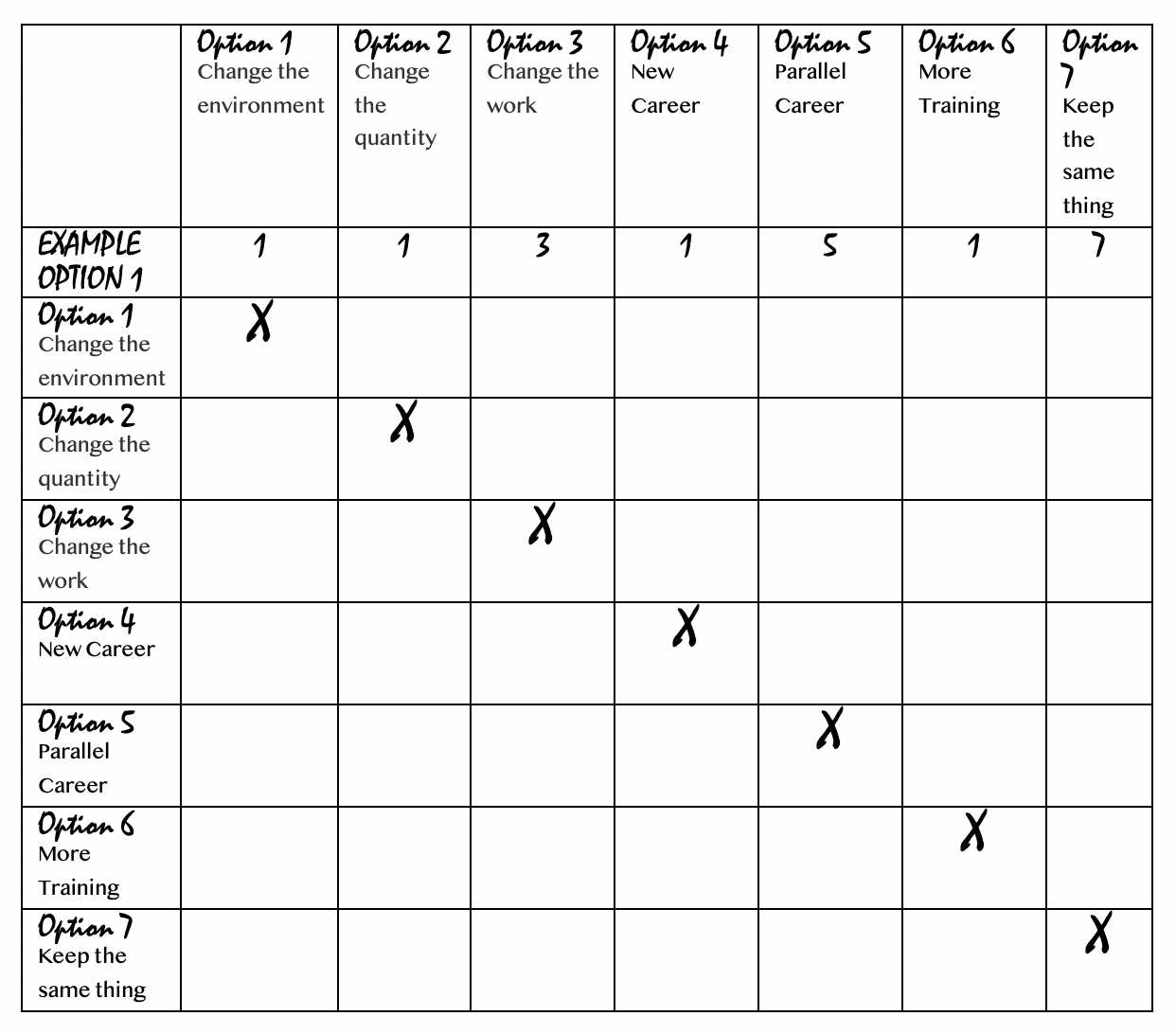The Overwhelm of Decision-Making in Transition - Clarity exercise Part 2
/See The Overwhelm of Decision-Making in Transition: Questions to ask - Part 1
When it comes to a vocational or career change, the possibilities appear unlimited. Our minds may take on a fight, flight or likely a freeze effect. The frontal lobe in our brain, acts like an overheated engine. It can’t take the myriad of options, so it begins to shut down…anxiety sets in. If we are able to employ a trusted friend or set of tools to gain perspective the ugly monster of overwhelm becomes a much more manageable companion.
We left off in the previous post (the overwhelm of decision-making part 1) with “together let’s approach the blocks that feel like an elephant and make them an eye - seeing them as an opportunity to explore, discover and create something new & life-giving! We can’t tackle the whole elephant right now, What feels most pressing?” Although the options may still take on 100 different variations, the primary decision can be broken down into just a handful of categories or even just one. How does one get from overwhelm to decision? What decision appears most pressing?
Now before we go any further, there exists an assumption that a well-thought through discernment process of gaining information about one’s options, talking to trusted individuals and mentors and a concerted amount of prayer, has gone into the process up to this point. Decision-making happens most effectively after a long season of discernment.
Transition takes place over the course of many small decisions, month after month. Getting to this point in making a major life decision primarily consists of listening to one’s heart and attending to the desires and longings of the soul that have existed for many months if not years. This point in time is often just a finalizing piece to a greater series of decisions. This is not to minimize the importance and the complexity. But rather to validate that your gut, your spouse, your friends, and God have all been speaking to you up to this point.
Decision-making happens most effectively after a long season of discernment.
In this post exists an exercise, a tool called the decision-making grid, to utilize in times of complicated or overwhelming decision-making. It’s quite simple and chances are you’re already familiar with it. A few years ago when faced with a series of decisions that seemed fit with equal pros and cons, I asked my friend and coach for some perspective. When she suggested using a decision-making grid I couldn’t conceptualize how it was different than making a list of pros and cons - my typical style! She briefly walked me through it over the phone. The simplicity almost seemed elementary. Yet it worked! Maybe like myself, you never thought to utilize it in major life decision. Here’s how it works.
The simplifying of options and narrowing down of questions, brings greater clarity than remaining in a place of swimming in the ocean of unlimited possibilities. In my opinion the process of discerning a major career move, organization or vocational path includes focusing first on personal fit (often referred to as calling). When we approach personal fit through the lense of these limited possibilities the decision-making begins to take the shape of a just a handful of possibilities.
Here we are talking primarily about decisions around personal fit and calling:
The 7 categories to consider personal fit/calling: (from the previous post The Overwhelm of Decision-Making in Transition)
1. Keep doing what I already do well but change the environment - Maybe you have outgrown the structure of the team or organization. Potentially staying in an environment, limits the opportunity for growth.
2. Keep the work; reallocate or change the quantity - some may consider focusing their target audience to better match their passion. As well, changing the quantity allows for specialization, influence and impact.
3. Change the work, but stay in the same environment - Within an organization maybe there is another set of possibilities. For example maybe you were hired on as an assistant but have outgrown the role where your gift mix would be better used.
4. Turn an avocation into a new career - many look towards their voluntary service opportunities as what they would ultimately like to do for life-giving work. For example, during a transition season in my life I went to a local hospital and asked if I could volunteer doing play therapy in the children’s ward. Amazing to me now, is the passion I’ve always had for kinesthetic healing!
5. Take on a parallel career For example, take your training role and look for another outlet like public speaking or book writing. This track is often pursued for the sake of funding, peer-mentoring, or influence.
6. Get more training - maybe the way forward for you requires a complete shift and more specialized training in a specific field of interest. This option affords one more discernment time as he/she researches a specific field.
7. Keep on doing the same thing - After a season of discernment and searching, you may have learned that what you have now is really a great fit and at this point nothing needs to change but something internally. Possibly it required an internal shift of gratitude or perspective to recognize the value of what you have and that every organization and team has faults. Answering, these are the ones I’m willing to live with!
I often recommend a sabbatical for a time of rest before major life decision-making. (See: “Overcoming the Top 3 Objections for taking a Sabbatical”) The need to clear one’s mind and gain perspective is invaluable in clarity gaining regardless of what decision may need to be made.
Where does one start in sorting through these 7 options and creating any semblance of a plan? Might I suggest as my mentor did, to utilize a decision-making grid?
When a decision-making grid is utilized, it allows one to see the options on paper and begin to compare them one against another not one to one million! Which is how it can often feel in your head. This process can help begin to make concrete the seemingly unlimited possibilities that can tend to have a swirling and overwhelming life of their own.
Here’s how a decision-making grid works:
1. Form the main question. Start by forming a question that you will use to evaluate all of the possibilities. Ask a question like: Which of these 7 options currently resonates most with me? If you are unable to get past this point, employ a friend or coach to help you form the question.
2. Make a table to represent your top 4-5 choices for your futures (a 5x5 table for example). An equal number of horizontal and vertical boxes will be used. It isn’t necessary to compare all 7 options as not all of them may be possibilities. Limiting the options is the goal at this point, not expanding.
3. Assign a number and short identifier such as an abbreviated description of your top choices in the top row and far left column. The list will be the same on both the left row and top column. So for example if you’re utilizing the list from above, you would consider #’s 1-7. If they are all options than they all go on the horizontal and vertical lines.
Vocational Discernment Decision-Making Grid Example
4. Put X’s on the numbers that coincide such as 3 vs 3 as you won’t be comparing the same number against itself.
5. Go through each row. When you compare number 1 to number 2, ask the question that you have chosen: “Which option more accurately aligns with my current longings? Or – Which option do I believe best allows for utilization of my personality & strengths? Or “Given our current family needs, which possibility is the best future fit?”
Note: You’ve already done the hard work…Don’t over-analyze. Go with your gut at this point.
6. Write the number chosen between the two options in the box. You will be comparing the same things twice, for example 2 vs. 4 and 4 vs. 2 it’s okay to change your mind or have a split. Often this double comparison produces double confirmation. But do not be alarmed if it does not!
7. After you’ve gone through the whole table, count up how many of each number you have: 1 - __, 2 - __, 3-__, 4-__, 5-__, 6-__
8. You should have a number with a higher total than the others.
9. At the end of this exercise, consider how the option with the top number of points sounds to you?
10. If all ends in a tie, consult a friend or sleep on it. Try on the different options wherever you land. If you’re truly at a place of being able to live into your decision, imaging your life in that change will provide you with new ideas for the future.
11. When all is done, run this decision by the same people that have helped you get to this point. Something like: Given what you know about where I’m at, does this sound like a good option for my future? Is there something else that I’m not considering? Surprisingly to many who are in transition is that those closest to the decision-maker already had a pretty good idea and are NOT surprised with a big decision. Call it intuition or a good friend. I would also call it the gift of being outside a cluttered decision-making mind.
The sweet dog ended up with the name Tracker. Unfortunately he only lived into that name as a sick rescue puppy for another 3 weeks. Our family misses him.
On a smaller scale our family recently used this method to decide on the name of our new dog. Not a perfect solution to over 30 ideas, but the process for four very different individuals created both a memorable exercise in decision-making and greater unity in the process. What became apparent was that there were many names not even worth considering. Similarly for you, many options not worth considering at this point for your future.
Utilizing a decision-making grid helps to shed light and gain clarity during complex decision-making times. The myriad of possibilities can now be broken down into only a handful or even just one. Concrete comparisons and intentional set-aside space allow for the ability to see the most important tree through the forrest of possibilities.
Don’t be surprised if this big decision catalyzes many decisions thereafter. Making a bold moves chart is a suggested next step. New blog post on “Now That You’ve Done a Decision-Making Grid, Bold Moves are Next” coming soon!
Questions to consider:
What do you learn from your created decision-making grid?
What is clearer after having done this exercise? Who do you need to share it with?











